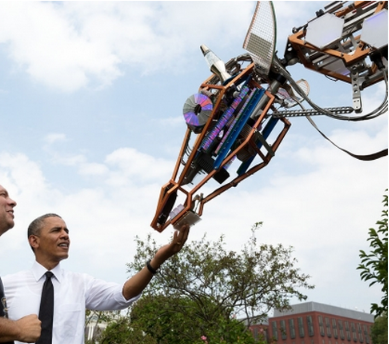2018 School Spending Survey Report
White House Declares June 18 "National Day of Making" and Launches Maker Initiatives for Libraries
On June 18, the White House hosted its very first Maker Faire, where the Institute of Museum and Library Services and LEGO Systems announced STEM and STEAM initiatives for libraries across the country.

President Obama looks at a student's 17-foot-tall, 2,200 lb. robotic giraffe on the South Lawn of the White House during the first White House Maker Faire, June 18, 2014. Photo credit: Official White House photo by Pete Souza
On June 18, President Obama hosted the first ever White House Maker Faire, an event where people of all ages could show the world the products they created, built, and designed using new technologies like 3-D printers, design software, and cutting edge laser technology. Obama declared June 18 the “National Day of Making,” an occasion to call upon “all Americans to observe this day with programs, ceremonies, and activities that encourage a new generation of makers and manufacturers to share their talents and hone their skills." The event highlighted the administration’s commitment to “dramatically expanding the number of students that have the opportunity to become makers" and investing in those who want to use science, technology, engineering, and math (STEM) to create innovative products and solutions, according to the White House fact sheet issued on June 18. This push for STEM initiatives to reach at-risk youths, who traditionally lack access to STEM education, will be carried out through through federal grants administered by the Institute of Museum and Library Services (IMLS) and free toolkits provided by LEGO Systems. Libraries have always played a major role in the informal education of their communities, IMLS director Susan Hildreth tells SLJ. “We really want to see how a library will provide services and programming around the makerspace,” Hildreth says. “[The] White House truly understands the flexibility, trust, and adaptability that libraries bring into communities.” While states are provided federal grants from IMLS each year, based on a population-based formula, the IMLS has no authority over the use of state money; however, the IMLS awards $25 million more in additional discretionary library grants through a rigorous application process, Hildreth explains. At the White House Maker Faire, the IMLS announced that of that $25 million, $1 million would be dedicated to applications focusing on STEM initiatives and makerspaces in libraries. (Although IMLS federal funds cannot be used for capital construction, libraries can apply for grants to procure more technology equipment.) To aid in the creation of these makerspaces and to assist librarians, IMLS also announced that it will be collaborating with partners such as the Pittsburgh Children’s Museum and the Chicago Public Library to create makerspace toolkits. Hildreth says resource material will be put together over the next year and a half and will be accessible online through the IMLS for free. The toolkits will contain information on available grants for makerspaces, advice on applications, and possible designs and examples of what other libraries and museums have done to further STEM education with their makerspaces at various funding levels and interest ranges The White House also announced the launch of informal makerspaces in libraries supported by free toolkits created by LEGO Systems and the LEGO Foundation. LEGO is partnering with the Association for Library Service to Children (ALSC) on this endeavor, called “Junior Makers Program,” aimed at children between the ages of four and six. Beginning this August, children’s librarians can access the online toolkit on the ALSC site to host LEGO-inspired makerspaces. LEGO’s digital toolkit will include instructions on how to build structures and scenes that come with popular LEGO sets. LEGO and ALSC also partnered to distribute physical LEGO makerspace toolkits to 750 libraries,15 in each state capital, which includes 10,000 LEGO blocks, in each kit, and other resource materials for educators. These toolkits were awarded through a lottery process. The hands-on activity of LEGOs can teach “segmenting and sequencing” in children, says ALSC president Starr LaTronica, who adds that such tactile play can make the maker initiative truly accessible. “You don't have to buy a [LEGO] kit to get instructions now, because the digital resource is full of... inspiration points,” she says and praises the kit’s flexibility. “If you have the resources, you can buy blocks,” LaTronica adds, noting that some libraries with scant resources successfully posted notices on Craigslist and community boards asking for donations of used LEGOs.Mythili Sampathkumar is a UN reporter and freelance journalist based in NYC and loves visiting old libraries and used book stores in every city she travels. Follow her on Twitter @RestlessRani.
RELATED
RECOMMENDED
CAREERS
The job outlook in 2030: Librarians will be in demand
CAREERS
The job outlook in 2030: Librarians will be in demand
ALREADY A SUBSCRIBER? LOG IN
We are currently offering this content for free. Sign up now to activate your personal profile, where you can save articles for future viewing






Add Comment :-
Be the first reader to comment.
Comment Policy:
Comment should not be empty !!!